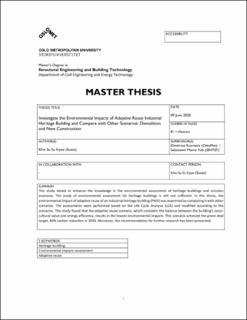Investigate the environmental impacts of adaptive reuse industrial heritage building and compare with other scenarios: Demolition and New construction
Master thesis
Published version
Permanent lenke
https://hdl.handle.net/11250/2774045Utgivelsesdato
2021Metadata
Vis full innførselSamlinger
Sammendrag
Nowadays, the environmental impact assessment is improved for new construction buildings. The European Commission targeted to achieve the 55% of carbon reduction in 2030 and 60% in 2050 compared to the 1990 carbon emission level. In the building and construction industry, constructing new buildings and manufacturing construction materials dominate the industries' total carbon emissions. There is also a large amount of building stock that is getting old, and most of the buildings have significant values in culture and society. Some of them are titled heritage buildings and must be preserved.
Furthermore, the heritage buildings are critical to preserve and rehabilitate due to there are a significant amount of heritage building and culturally valuable buildings which were built within the industrial revolution time. Most of the non-residential buildings are not possible to use the original purpose. Then, the rehabilitation of the building must be carried out. However, since the heritage buildings have a high value in culture and society, the professional bodies are considering carefully. On the other hand, the environmental consideration for the heritage building is also critical. The heritage building always has had a long service life; precisely, the service life is longer than expected. Therefore, the environmental impacts of the building use must be studied. Life cycle stages and the building's lifespan are the influencing factors for the building's environmental impacts. The life cycle analysis method is used for the new construction, but environmental impacts assessment of the heritage building has not been established yet. The author believed that the environmental assessment for the heritage building could be carried out by modifying the life cycle assessment.
This research aims for a broader insight study in environmental assessment and circular economy. The outcomes of the study enhanced the knowledge of environmental assessment for heritage buildings. The objective is to investigate the rehabilitation of an industrial heritage building (PM5) in Skien, Norway, comparing it with other scenarios. Life cycle assessment analysis was used as a based method for this heritage infrastructure and modified according to the scenarios' system boundary. The adaptive reuse scenario without considering the energy performance was the most favorable scenario among all the scenarios.
Moreover, the aspects to determine the environmental assessment of heritage buildings were studied. One-Click LCA is used as an assessment tool to evaluate the environmental impacts. Heritage building's components and materials have heritage value and socio-cultural values same as the whole heritage building. Therefore, each component of the building also must be preserved. This study found that the most suitable way to rehabilitate a heritage building is to reuse it as a non-heated public building. Moreover, the recommendation of reusing the replaced components and further studies are presented.
